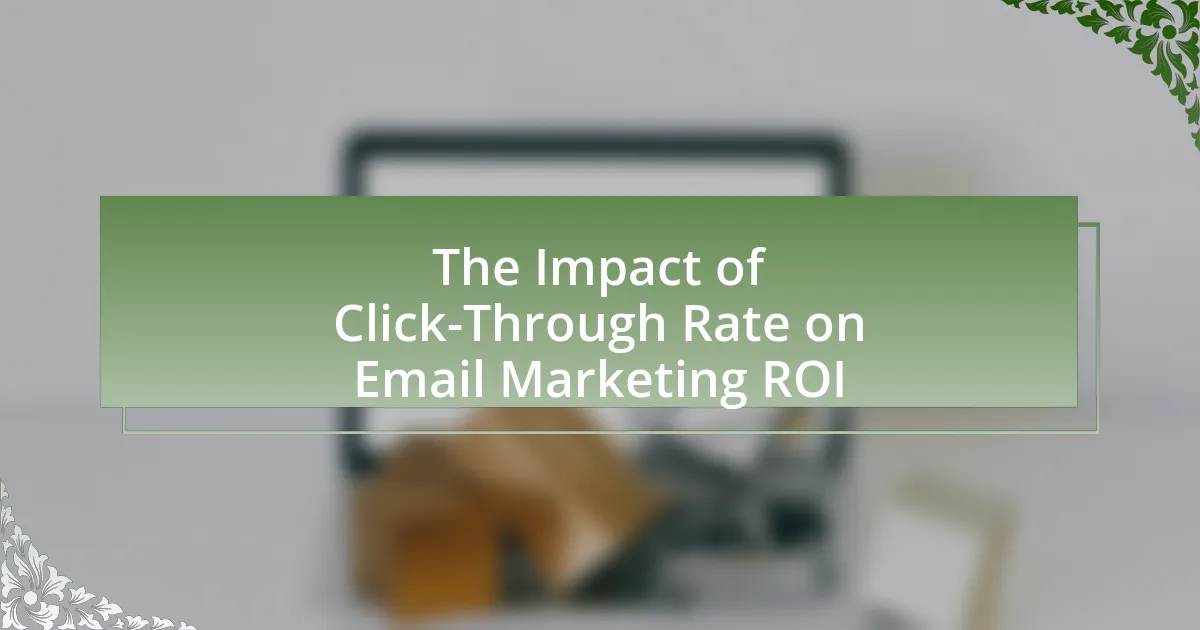Bounce rates in email marketing are a critical metric that indicates the percentage of emails that fail to reach recipients’ inboxes, reflecting the quality of an email list and overall campaign effectiveness. This article explores the definitions of bounce rates, distinguishing between hard and soft bounces, and their implications for email deliverability and sender reputation. It also examines factors contributing to high bounce rates, the importance of email list management, and strategies for reducing bounces through segmentation and regular list cleaning. Additionally, the article highlights common misconceptions about bounce rates and provides practical steps for optimizing email strategies to enhance engagement and deliverability.

What are Bounce Rates in Email Marketing?
Bounce rates in email marketing refer to the percentage of emails that cannot be delivered to the recipient’s inbox. This metric is crucial for assessing the effectiveness of an email marketing campaign, as a high bounce rate indicates issues with the email list quality or deliverability. According to a study by Mailchimp, the average bounce rate across various industries is approximately 0.7%, highlighting the importance of maintaining a clean and verified email list to minimize undeliverable messages.
How are Bounce Rates Defined?
Bounce rates are defined as the percentage of visitors who navigate away from a website after viewing only one page. This metric indicates the effectiveness of a webpage in engaging visitors; a high bounce rate suggests that users are not finding what they expected or are not compelled to explore further. According to Google Analytics, a bounce occurs when a user enters a site and leaves without interacting with any other pages, making bounce rates a critical measure for assessing user engagement and content relevance.
What distinguishes a hard bounce from a soft bounce?
A hard bounce occurs when an email cannot be delivered due to a permanent reason, such as an invalid email address or a domain that does not exist. In contrast, a soft bounce happens when an email is temporarily undeliverable, often due to issues like a full inbox or a server being down. The distinction is critical for email marketers, as hard bounces indicate a need to remove invalid addresses from mailing lists, while soft bounces may resolve themselves over time.
How do bounce rates impact email deliverability?
Bounce rates negatively impact email deliverability by signaling to email service providers that a sender may be untrustworthy or using poor list management practices. High bounce rates indicate that a significant number of emails are not reaching valid addresses, which can lead to the sender being flagged or blacklisted by email providers. For instance, a bounce rate exceeding 2% can trigger scrutiny from providers, resulting in reduced inbox placement rates. This correlation is supported by data from various email marketing studies, which show that maintaining a low bounce rate is crucial for sustaining a positive sender reputation and ensuring successful email delivery.
Why are Bounce Rates Important for Email Strategy?
Bounce rates are important for email strategy because they indicate the effectiveness of email deliverability and the quality of the email list. High bounce rates suggest that a significant number of emails are not reaching their intended recipients, which can negatively impact sender reputation and future deliverability. According to a study by Mailchimp, a bounce rate above 2% can lead to decreased engagement and increased chances of being marked as spam. Monitoring and analyzing bounce rates allows marketers to refine their email lists, remove invalid addresses, and improve overall campaign performance.
What insights can bounce rates provide about your email list quality?
Bounce rates provide critical insights into the quality of your email list by indicating the proportion of emails that could not be delivered to recipients. A high bounce rate suggests that a significant number of email addresses on your list are invalid or outdated, which directly impacts the effectiveness of your email marketing efforts. For instance, according to a study by Mailchimp, lists with a bounce rate above 2% are often considered low quality, as they may contain numerous inactive or incorrect addresses. This data highlights the importance of regularly cleaning and validating your email list to maintain high deliverability rates and engagement levels.
How do bounce rates affect sender reputation?
Bounce rates negatively impact sender reputation by indicating poor list quality and engagement. High bounce rates suggest that a significant number of emails are not reaching valid recipients, which can lead email service providers to classify the sender as untrustworthy. For instance, a bounce rate exceeding 2% can trigger warnings from email platforms, potentially resulting in reduced deliverability rates. This correlation is supported by industry data showing that senders with consistent high bounce rates face increased scrutiny and may experience blacklisting, further harming their reputation.

What Factors Contribute to High Bounce Rates?
High bounce rates are primarily influenced by factors such as irrelevant content, poor user experience, and slow loading times. Irrelevant content fails to meet user expectations, leading to quick exits; for instance, a study by Google found that 53% of mobile users abandon sites that take longer than three seconds to load. Additionally, a cluttered or confusing website design can frustrate visitors, causing them to leave without engaging. Furthermore, targeting the wrong audience can result in high bounce rates, as users who receive emails that do not align with their interests are less likely to stay on the site. These factors collectively contribute to a higher likelihood of users bouncing from a webpage.
How does Email List Management Influence Bounce Rates?
Email list management significantly influences bounce rates by ensuring that only valid and engaged email addresses are included in the distribution list. Effective management practices, such as regular list cleaning and validation, reduce the likelihood of sending emails to inactive or incorrect addresses, which directly lowers the bounce rate. According to a study by Mailchimp, lists that are regularly cleaned can experience bounce rates as low as 0.5%, compared to rates exceeding 5% for poorly managed lists. This demonstrates that proactive email list management not only enhances deliverability but also improves overall email campaign performance.
What role does list hygiene play in reducing bounces?
List hygiene plays a critical role in reducing bounces by ensuring that email lists contain only valid, engaged, and active recipients. Maintaining list hygiene involves regularly cleaning the email list to remove invalid addresses, duplicates, and inactive users, which directly decreases the likelihood of emails bouncing back. According to a study by Mailchimp, lists that are regularly cleaned can see bounce rates drop by up to 30%, as removing non-existent or unresponsive addresses enhances deliverability and engagement rates.
How can segmentation improve bounce rates?
Segmentation can improve bounce rates by allowing marketers to tailor content to specific audience groups, thereby increasing engagement. When emails are segmented based on criteria such as demographics, behavior, or preferences, recipients are more likely to find the content relevant, which reduces the likelihood of them immediately leaving the page. Research indicates that segmented campaigns can lead to a 760% increase in revenue, as targeted messaging resonates better with the audience, resulting in lower bounce rates.
What Technical Issues Can Cause Bounces?
Technical issues that can cause bounces include server misconfigurations, invalid email addresses, and spam filters. Server misconfigurations, such as incorrect DNS settings or issues with the mail server, can prevent emails from being delivered, leading to hard bounces. Invalid email addresses, often due to typos or outdated information, result in immediate bounces when the email cannot be found. Additionally, spam filters may block emails based on content or sender reputation, causing soft bounces. According to a study by Return Path, 20% of emails are blocked by spam filters, highlighting the significance of these technical issues in email deliverability.
How do server issues lead to email bounces?
Server issues lead to email bounces primarily due to the inability of the sending or receiving server to process the email. When a server is down, overloaded, or misconfigured, it cannot accept incoming messages, resulting in a bounce notification sent back to the sender. For instance, if the recipient’s server is temporarily unavailable, the email cannot be delivered, leading to a “temporary bounce.” Additionally, if the sending server is blacklisted due to spam complaints or technical errors, emails may be rejected outright, causing “permanent bounces.” These scenarios illustrate how server-related problems directly impact email deliverability and contribute to bounce rates.
What are common formatting errors that result in bounces?
Common formatting errors that result in bounces include invalid email addresses, excessive use of special characters, and incorrect domain formats. Invalid email addresses often occur when users mistype their information, leading to non-existent accounts. Excessive special characters can confuse email servers, causing them to reject the message. Incorrect domain formats, such as missing the “@” symbol or using an unregistered domain, also lead to delivery failures. According to a study by Return Path, nearly 20% of emails bounce due to formatting issues, highlighting the importance of accurate email entry and validation processes.

How Can You Analyze and Improve Bounce Rates?
To analyze and improve bounce rates, utilize web analytics tools to track user behavior and identify pages with high bounce rates. By examining metrics such as time on page, exit pages, and user demographics, you can pinpoint specific content or design issues that may be causing users to leave without engaging. For instance, a study by Google indicates that a one-second delay in page load time can lead to a 20% increase in bounce rates, highlighting the importance of optimizing site speed. Implementing changes based on these insights, such as improving content relevance, enhancing user experience, and ensuring mobile optimization, can effectively reduce bounce rates and increase user engagement.
What Tools are Available for Monitoring Bounce Rates?
Google Analytics is a widely used tool for monitoring bounce rates, providing detailed insights into user behavior on websites. It tracks the percentage of visitors who leave a site after viewing only one page, allowing marketers to assess the effectiveness of their content and user engagement. Additionally, tools like Adobe Analytics and Matomo offer similar functionalities, enabling businesses to analyze bounce rates and optimize their email strategies based on user interaction data. These tools are validated by their extensive use in the industry, with Google Analytics alone reporting over 29 million websites utilizing its services as of 2023.
How can analytics platforms help in tracking bounce rates?
Analytics platforms assist in tracking bounce rates by providing detailed metrics on user interactions with emails and websites. These platforms collect data on how many users leave a page without engaging, allowing marketers to identify patterns and potential issues in their email strategies. For instance, Google Analytics offers features that enable users to monitor bounce rates in real-time, segment data by traffic sources, and analyze user behavior, which helps in pinpointing specific content or design elements that may be causing high bounce rates. This data-driven approach allows for informed adjustments to improve user engagement and overall email effectiveness.
What metrics should be considered alongside bounce rates?
Metrics that should be considered alongside bounce rates include conversion rates, click-through rates (CTR), and average session duration. Conversion rates indicate the percentage of visitors who complete a desired action, providing insight into the effectiveness of the email strategy. Click-through rates measure the proportion of recipients who click on links within the email, reflecting engagement levels. Average session duration tracks how long users stay on the site after clicking through, which can indicate content relevance and user interest. These metrics collectively offer a comprehensive view of user engagement and the overall success of email campaigns.
What Strategies Can Reduce Bounce Rates?
To reduce bounce rates, implement strategies such as optimizing email content for relevance, personalizing messages, and ensuring mobile compatibility. Research indicates that personalized emails can increase engagement rates by up to 29%, as highlighted in a study by Experian. Additionally, segmenting your audience based on behavior and preferences allows for more targeted messaging, which can lead to a 760% increase in revenue, according to the Direct Marketing Association. Ensuring that emails are mobile-friendly is crucial, as 61.9% of emails are opened on mobile devices, according to Litmus. These strategies collectively enhance user experience and engagement, thereby reducing bounce rates effectively.
How can regular list cleaning improve email performance?
Regular list cleaning improves email performance by ensuring that only engaged and valid recipients receive communications. This practice reduces bounce rates, as outdated or incorrect email addresses are removed, leading to higher deliverability rates. According to a study by Mailchimp, emails sent to clean lists can achieve open rates up to 20% higher compared to those sent to unclean lists. Additionally, maintaining a clean list enhances sender reputation, which is crucial for avoiding spam filters and improving overall engagement metrics.
What best practices should be followed for email design to minimize bounces?
To minimize bounces in email design, ensure that your email list is clean and up-to-date. Regularly removing invalid or inactive email addresses reduces the likelihood of sending to non-existent accounts, which directly decreases bounce rates. According to a study by Mailchimp, maintaining a clean list can improve deliverability rates by up to 20%. Additionally, using double opt-in methods for subscriptions confirms the validity of email addresses, further enhancing list quality. Implementing responsive design ensures that emails render correctly across devices, which can also improve engagement and reduce the chances of bounces due to user dissatisfaction.
What are the Common Misconceptions About Bounce Rates?
Common misconceptions about bounce rates include the belief that a high bounce rate always indicates poor content quality and that it solely reflects user dissatisfaction. In reality, a high bounce rate can occur for various reasons, such as users finding the information they need quickly or accessing a single-page site. Additionally, bounce rates can vary significantly across different industries and types of content, making it essential to consider context when interpreting these metrics. For instance, a blog post may have a high bounce rate but still engage users effectively if they spend time reading the content before leaving. Understanding these nuances is crucial for accurately assessing the effectiveness of an email strategy and overall website performance.
Why is it a mistake to ignore bounce rates in email marketing?
Ignoring bounce rates in email marketing is a mistake because high bounce rates indicate issues with email deliverability and list quality. When emails bounce, it signifies that they are not reaching the intended recipients, which can negatively impact sender reputation and future deliverability rates. According to a study by Mailchimp, emails with high bounce rates can lead to a decrease in overall engagement and can trigger spam filters, further reducing the effectiveness of email campaigns. Therefore, monitoring and addressing bounce rates is crucial for maintaining a healthy email marketing strategy and ensuring successful communication with the target audience.
How can misunderstanding bounce rates lead to poor email strategies?
Misunderstanding bounce rates can lead to poor email strategies by causing marketers to misinterpret the effectiveness of their campaigns. When marketers fail to distinguish between hard bounces, which indicate invalid email addresses, and soft bounces, which are temporary delivery issues, they may incorrectly assess their audience engagement and list quality. For instance, a high bounce rate might prompt unnecessary list scrubbing or changes in targeting, ultimately reducing the reach to potential customers. According to a study by Mailchimp, emails sent to invalid addresses can inflate bounce rates, leading to misguided decisions that negatively impact overall email performance and engagement metrics.
What Practical Steps Can You Take to Optimize Your Email Strategy?
To optimize your email strategy, focus on segmenting your audience based on behavior and preferences. This allows for targeted messaging, which can increase engagement rates. According to a study by Mailchimp, segmented campaigns have an average open rate of 14.32% higher than non-segmented campaigns. Additionally, regularly cleaning your email list to remove inactive subscribers can reduce bounce rates and improve deliverability. Research from Return Path indicates that maintaining a clean list can enhance sender reputation, leading to better inbox placement. Implementing A/B testing for subject lines and content can also provide insights into what resonates with your audience, further refining your strategy.




